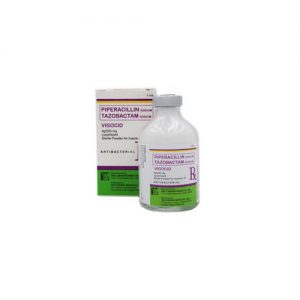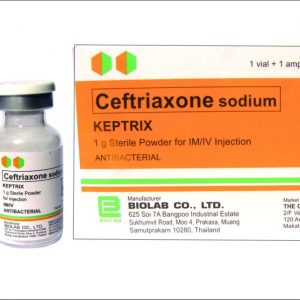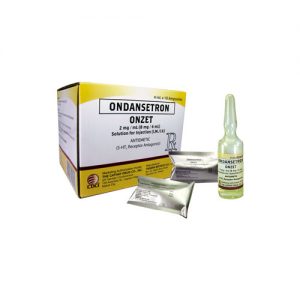Description
The Cathay Drug Co., Inc.
FORMULATION:
Each 500 mg/ 100 mg vial contains 500 mg Amoxicillin as sodium salt and 100 mg Clavulanic acid as potassium clavulanate
Each 1 g/ 200 mg vial contains 1 g Amoxicillin as sodium salt and 200 mg Clavulanic acid as potassium clavulanate
ANTIMICRIBIAL ACTION:
The spectrum of activity of Amoxicillin may be extended by the concomitant use of Beta-lactamase inhibitor such as Clavulanic acid. As well as reversing resistance to Amoxicillin in Beta-lactamase producing strains of species otherwise sensitive, Clavulanic acid has also been reported to enhance the activity of Amoxicillin against several species not generally considered sensitive. Bactiv is bactericidal to a wide range of organism including
| Gram positive aerobes: | Enterococcus faecalis, Streptococcus pneumonia, Streptococcus pyogenes, Streptococcus viridans, * Streptococcus aureus, * Coagulase negative staphylococci (including Staphylococcus epidermidis), Corynebacterium species, Bacillus anthracis, Listeria monocytogenes. |
| Gram positive anaerobes: | Clostridium species, Peptococcus species, Peptostreptococcus species. |
| Gram negative aerobes: | Haemophilus influenza, * Escherichia coli, * Proteus mirabilis, * Protues vulgaris, * Klebsiella species, * Moraxella catarrhalis, * Salmonella species, * Shigella species, * Bordetella pertussis, Brucella species, Neisseria gonorrheae, Neisseria meningitides, Vibrio Cholerae, Pasteurella multocida. |
| Gram negative anaerobes: | Bacteroides including B. Fragilis, * Including Beta-lactamase producing strains resistant to ampicillin and amoxicillin. |
INDICATIONS
Bacterial infections caused by amoxicillin-resistant beta-lactamase producing strains. These includes:
- Sinusitis, otitis media, recurrent tonsillitis
- Acute exacerbations of chronic bronchitis
- Bronchopneumonia
- Urinary tract infections, especially when recurrent or complicated, but not prostatitis
- Septic abortion, pelvic or puerperal sepsis and intra-abdominal sepsis
- Cellulitis animal bites, and severe dental abscess with spreading cellulitis
ABSORPTION AND EXCRETION
Amoxicillin and Clavulanate appear to be well-absorbed into systemic circulation after administration of the oral tablet or suspension formulations. The pharmacokinetics disposition characteristics of Amoxicillin and Clavulanate are unaffected when the two drugs are administered at the same patient. In contrast, a minor yet statistically significant decrease in the time to reach the peak serum Amoxicillin concentration (Tmax) and a slight increase in the peak serum Amoxicillin concentration (Cmax) was reported when the drug combination was co-administered with magnesium hydroxide and/or aluminum hydroxide antacids. No such effect on these or any other pharmacokinetic parameters have been described for Clavulanate. This difference, observed in the Tmax and Cmax for Amoxicillin when co-administered with antacids, would appear to be of little to no clinical significance. Amoxicillin is primarily eliminated from the body by the kidney as unchanged drug and undergoes active renal tubular secretion and thud concurrent probenecid will competitively inhibit the clearance of the drug. Clavulanic acid undergoes considerable metabolism although, the route is unknown. It is postulated that Clavulanic acid is hydrolyzed with subsequent decarboxylation. The Clavulanic acid that is excreted in the urine appears to undergo simple glomerular filtration with no active secretion. Clearance of Clavulanic acid decreases with decreasing renal function, but not to the sasme extent as for Amoxicillin. Clavulanic acid is removed by hemodialysis.
DOSAGE AND ADMINISTRATION
| Dosages for the treatment of infections | |
| Adults & Children > 12 yrs | Usually 1 g/ 200 mg eight hourly. For serious infections, increase frequency to six-hourly intervals. |
| Children 3 mos. – 12 yrs | Usually 30 mg/kg eight hourly. For serious infections, increase to six-hourly intervals. |
| Children 0 – 3 mos. | 30 mg/kg* every 12 hours in premature infants and in full terms infants during the perinatal period, increasing to eight hours thereafter. |
* Each 30 mg Bactiv contains 25 mg Amoxicillin and 5 mg Clavulanic Acid.
| Dosage for Surgical Prophylaxis |
| The usual dose is 1 g/ 200 mg Bactiv intravenous given at the induction of anesthesia operations where there is a high risk of infections, e.g. Colorectal surgery, may require three, and up to four, doses of 1 g/ 200 mg Bactiv in a 24-hour period. These doses are usually given at 0, 8, 16 and 24 hours. This regimen can be continued for several days if the procedure has a significantly increased risk of infection. Clear clinical signs of infection at operation will require a normal course of intravenous or oral Bactiv therapy post-operatively. |
| Dosage in Renal Impairment | ||
| Adult
Mild Impairment (Creatinine Clearance) > 30 mL/min No change in doses |
Moderate Impairment (Creatinine Clearance) 10 -30 mL/min 1 g/ 200 mg I.V. Stat followed by 600 mg I.V. 12 hourly |
Severe Impairment (Creatinine Clearance) < 10 mL/min 1 g/ 200 mg I.V. Stat followed by 500 mg/ 100 mg I.V. 24 hourly. Dialysis decrease serum conc. of Bactiv and an additional 500 mg/ 100 mg I.V. Dose may need to be given during dialysis and at the end of dialysis. |
| Children Similar reductions in dosage should be made for children | ||
| Dosage in Hepatic Impairment | ||
| Dose with caution; monitor hepatic function at regular intervals | ||
Bactiv may be administered either by intravenous injection or by intermittent infusion. It is not suitable for intramuscular administration.
Intravenous Injection
The stability of Bactiv intravenous solution is concentration dependent, thus it should be used immediately upon reconstitution and given by slow intravenous over a period of 3-4 minutes. Intravenous solution should be used within 20 minutes after reconstitution. It may be injected directly into a vein or via drip tube.
Intravenous Infusion
Bactiv may be infused in Water for Injection B.P. or Sodium Chloride Intravenous Injection B.P. (0.9% w/v). Add without delay, 500 mg/ 100 mg reconstituted solution to 50 mL infusion fluid or 1 g/ 200 mg reconstituted solution to 100 mL infusion fluid (e.g. using mini bag or in-line burette). Infuse over 30-40 minutes and complete within four hours of reconstitution.
* Solutions should be made to full infusion volume immediately after reconstitution.
DIRECTION FOR RECONSTITUTION
For 500 mg/ 100 mg and 1 g/ 200 mg vials, dissolve contents in 10 mL and 20 mL of Water for Injections B.P., respectively. Final volume is 10.5 mL in 500 mg/ 100 mg and 20.9 mL in 1 g/ 200 mg vials.
STABILITY AND COMPATIBILITY
Satisfactory antibiotic concentrations are retained at 5°C and at 25°C in the recommended volumes of the following infusion fluids. If reconstituted and maintained at 25°C, infusions should be completed within the time started.
| Intravenous Infusion Fluid | Stability Period at 25°C | Stability Period at 5°C |
| Water for Injections B.P.
Sodium Chloride I.V. Infusion B.P. (0.9% w/v) Sodium Lactate I.V. Infusion B.P. (one sixth molar) |
4 hours
4 hours 4 hours |
8 hours
8 hours 8 hours |
| Compound Sodium Chloride Intravenous Infusion B.P. (Ringers Solution)
Compound Sodium Lactate Intravenous Infusion B.P. (Ringers-Lactate Solution; Hartmann’s Solution) Potassium Chloride and Sodium Chloride Intravenous Infusion B.P. |
3 hours
3 hours
3 hours |
For storage at 5°C, the reconstituted solution should be added to pre-refrigerated infusion bags which can be stored for up to 8 hours. Thereafter, the infusion should be administered immediately after reaching 25°C. Reconstituted solutions should not be frozen. Reconstituted solutions should not be added to infusions containing glucose, dextran bicarbonate nut may be injected into the drip tubing over a period of 3-4 minutes.
CONTRAINDICATION
Penicillin hypersensitivity.
PRECAUTIONS
In general, Bactiv is well tolerated and possesses the characteristic low toxicity of the penicillin group of antibiotic. It should be used with care in patients with evidence of severe hepatic dysfunction. Cholestatic jaundice which may be severe, but usually reversible has been reported rarely; signs and symptoms may not become apparent for up to 6 weeks after cessation of treatment. Dosage should be adjusted as recommended in the “Dosage and Administration” section in patients with moderate or severe renal impairment. Periodic assessments of organ system functions, including hepatic, renal and hemopoietic function is advisable during prolonged therapy or in patients with evidence of severe hepatic dysfunction. Prolongation of bleeding time and prothrombin time have been reported in some patients receiving Bactiv. It should be used with care in patients on anticoagulant therapy. Attention should also be paid to possible cross-sensitivity with other Beta-lactam antibiotics, e.g. Cephalosphorins. Before initiating treatment with Bactiv, careful inquiry should be made concerning previous hypersensitivity reactions to penicillin. Prolonged use may also occasionally result in overgrowth of non-susceptible organisms.
USE IN PREGNANCY AND LACTATION
Animal studies with orally and parenterally administered Bactiv have shown no teratogenic effects. It has been used in human pregnancy in a limited number of cases with no untoward effect. However, use during pregnancy is not recommended unless considered essential by the physician. Therapy with Bactiv during pregnancy should be avoided if at all possible, especially during the 1st trimester. During lactation, trace quantities of penicillin can be detected in breast milk.
SIDE EFFECTS
Side effects are uncommon and mainly of a mild and transitory nature. Diarrhea, pseudomembranous colitis, indigestion, vomiting, candidiasis and phlebitis at the site of injection have been reported. Nausea, although uncommon, is more often associated with higher oral dosages. Gastrointestinal side effects may be reduced by taking oral Bactiv at the start of meals. Hepatitis and cholestatic jaundice have been reported rarely and are usually reversible. Rare cases of erythema multiforme (including Stevens-Johnson syndrome), toxic epidermal necrolysis and exfoiative dermatitis have been reported. Transient leukopenia and thrombocytopenia have been reported during treatment with penicillins. A moderate AST and/or ALT has been noted in patients with semisythetic penicillins but the significance of these findings is unknown.
OVERDOSAGE
Problems of overdosage are unlikely to occur; if encountered, thay may be treated symptomatically and removed from the circulation by hemodialysis.
INTERACTIONS
Co-administration of probenecid cannot be recommended. Probenecid decreases the renal tubular secretion of Amoxicillin. Concurrent use with Bactiv may result in increased and prolonged levels of Amoxixillin, but not the Clavulanic acid. There are no data with Allopurinol administered concurrently. It should not be co-administered with Disulfiram. The ingestion of alcohol should be avoided during and several days after treatment with Bactiv. In common with other broad-spectrum antibiotics, Bactiv may reduce the efficacy of oral contraceptives, and patients should be warned accordingly.
AVAILABILITY
BACTIV 500 mg/ 100 mg vial in box of 1’s
BACTIV 1 g/ 200 mg vial in box of 1’s
STORAGE
Intravenous presentations (dry powder) should be stored in a refrigerator at 5°C.
Use immediately upon reconstitution. Reconstituted solutions should not be frozen.
CAUTION
Foods, Drugs, Devices and Cosmetics Act prohibits dispensing without prescription.
Manufactured by
YSS LABORATORIES CO., INC.
1133 U.N. Ave., Paco, Manila
Distributed by
THE CATHAY DRUG CO., INC.
2/F Vernida 1 Condominium
120 Amosolo St., Legaspi Village, Makati City
Date of revision: July 2016






Reviews
There are no reviews yet.